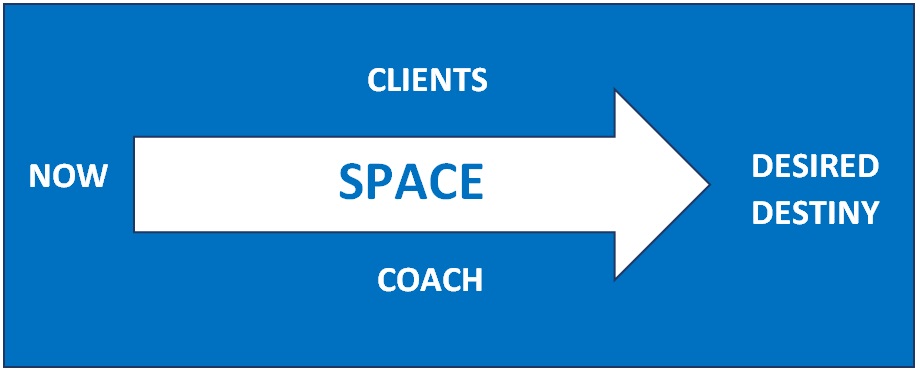A Coaching Model Created by Yin Yin Sew
(Life Coach, MALAYSIA)
 Overview
Overview
My role as a coach is to journey alongside the clients to reach the clients’ desired destiny and help them to write their own stories. The arrow implies a process that helps the clients to move forward with confidence in the midst of life changes or challenges. It is also a process that the clients present their current situation and clarifies how to present learnings that can be applied in the future. Throughout the process, my clients’ agendas are above mine. I will ensure that my clients are overall responsible for their goals, vision statement, and action plans.
The SPACE coaching model is a 5 steps process that helps my clients move from the current state of their lives to their desired destinies.
S: Safe space/ environment
It takes courage for the clients to approach a coach because they do not know the expectation of the coaching sessions. They may be nervous to share their issues with a coach whom they have not met before. Hence, I need to build rapport with the clients and create a safe space for my clients at the beginning of the coaching journey.
Approaches:
Examples of coaching questions:
Situation
After the clients understand the coaching process and expectations, I can get to know the clients’ situation.
Examples of coaching questions:
P: Purpose
It is important to find out the purpose of the coaching session and clarify the session goals. At times, the clients may have some awareness of their situation which includes their strengths and capabilities, but they may lack clear goals and structured ways to identify their goals.
Examples of coaching questions
Other than clarifying with clients about their goals, I can clarify their life purposes in coaching sessions.
Examples of coaching questions:
Powerful questions
I can ask powerful questions that create an opportunity for the clients to pause, take a step back, think, reflect, reframing the presenting issues. Powerful questions can also help the clients to stimulate new perspectives, clarify issues, and explore various options. It does not confine to the “here & now” moment, but helping clients to glance to the future, experience glimmers of hope, and recognize that change and progress are possible.
Examples of coaching questions:
A: Active Listening
Active listening is key in showing support and build a coaching relationship. At the same time, I listen to clarify issues and get a clearer picture of the clients’ concerns and perspectives.
Approaches
Awareness
Stimulate self-awareness
Walking alongside the client to help the clients be aware of their present and who the clients really are by asking powerful questions and applying active listening. Stimulating self-awareness helps the clients to grow and have a purposeful and fulfilling life.
Examples of coaching questions
C: Curiosity
Curiosity is not about digging into more information about the clients and their situations. It is about helping coaches to think about their clients’ values, perspectives, lifestyles, goals, feelings, and relationships. As a coach, I need to show curiosity in the way to show the greatest concern about clients. This could help to build relationships for the coaching sessions.
Examples of coaching questions:
Communication effectively
Given the right time, I need to communicate effectively to my clients by providing feedback, reframing the perspectives, or using metaphor and analogy to highlight a point and help clients to visualize the situation. I must communicate clearly and respectfully using appropriate language. Knowing the culture of my clients help me to communicate effectively without jeopardizing the coaching relationship.
Examples of communication effectively
E: Encouragement
Encouragement gives optimism and hopes. During the coaching process, I will look for behavior and events that are positive and worth encouraging. When encouragement is given to the clients who are stuck during the coaching process, the clients will be motivated and have the boldness to take risks and move forward because encouragement stimulates growth. Encouragement should be given specifically and in an authentic manner.
Examples of Encouraging statements
Evolvement
Changes require actions. This is the stage where clients will be developing their action plans, setting smart goals and casting vision, finding a support system to move forward. After casting vision and setting smart goals, the clients will work on their action plans to achieve what they want.
Examples of Coaching questions:
Exploration
During the exploration process, it is an opportunity for the clients to consider the multiple options and possibilities in making a decision.
At times, it is not easy for clients to achieve their goals. Obstacles do occur. I will help the clients to uncover the potential obstacles and explore ways to overcome the obstacles so that the growth progress will not be hindered.
During the exploration process, it is an opportunity for the clients to consider the multiple options and possibilities in making a decision.
Example of coaching questions:
Ultimately, I hope that the SPACE coaching model provides a safe space for my clients to write their own unique life stories and reach their desired destination.
References
David B. Peterson (2010). Good to Great Coaching: Accelerating the Journey.
John Campbell. The Power of Encouragement.
Barb Pierce (2014, November). Acknowledgment: A Powerful Tool to Grow Individuals and Teams.
Catherine Moore (2020, February). 100 Most Powerful Life Coaching Questions.
Carly Anderson (2020, May). Why direct communication is an essential coaching competency.
Gary R. Collins (2009), Helping Others Turn Potential Into Reality – Christian Coaching(2nd Edition), Colorado, NavPress.